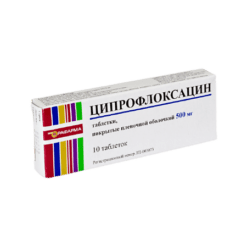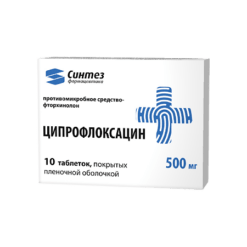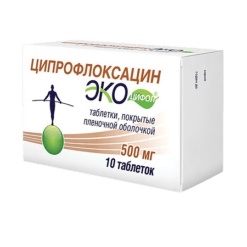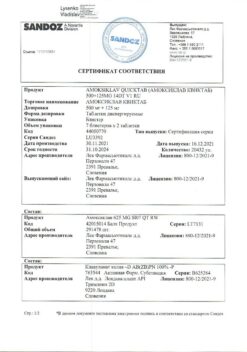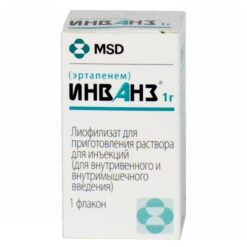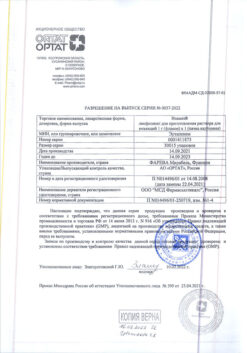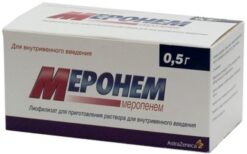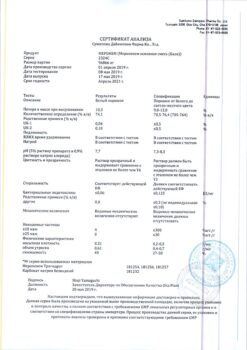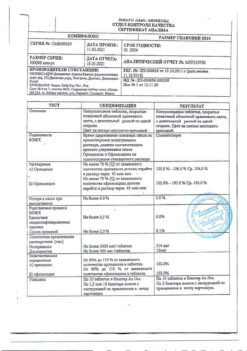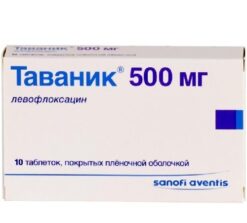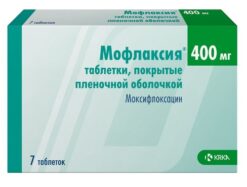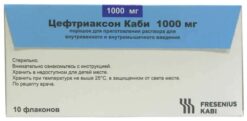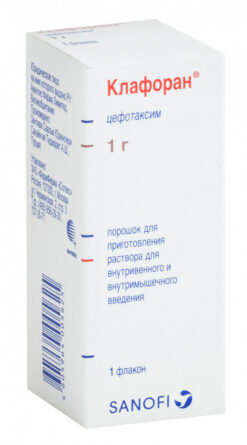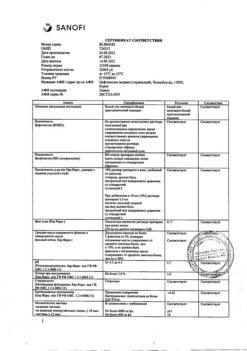No products in the cart.
Ciprofloxacin, 200 mg/100 ml 100 ml
€1.99 €1.66
Description
Pharmacotherapeutic group
Antimicrobial agent, fluoroquinolone
ATX code
J01MA02
Pharmacodynamics:
A broad-spectrum antimicrobial from the group of fluoroquinolones.
Acts bactericidal. The drug inhibits bacterial enzyme DNA-zytase, which disrupts DNA replication and synthesis of bacterial cell proteins. Ciprofloxacin acts both on multiplying microorganisms and on those which are in the quiescent phase.
Ciprofloxacin is sensitive to Gram-negative aerobic bacteria: enterobacteriaceae (Escherichia coli Salmonella spp. Shigella spp. Citrobacter spp. Klebsiella spp. Enterobacter spp. Proteus mirabilis Proteus vulgaris Serratia marcescens Hafnia alvei Edwardsiella tarda Providencia spp. Morganella morganii Vibrio spp. Yersinia spp.) other Gram-negative bacteria (Haemophilus spp. Pseudomonas aeruginosa Moraxella catarrhalis Aeromonas spp. Pasteurella multocida Plesiomonas shigelloides Campylobacter jejuni Neisseria spp.); some intracellular pathogens: Legionella pneumophila Brucella spp. Chlamydia trachomatis Listeria monocytogenes Mycobacterium tuberculosis Mycobacterium kansasii Mycobacterium avium-intracellulare.
The following Gram-positive aerobic bacteria are also sensitive to ciprofloxacin: Staphylococcus spp. (Staphylococcus aureus Staphylococcus haemolyticus Staphylococcus hominis Staphylococcus saprophyticus) Streptococcus spp. (Streptococcus pyogenes Streptococcus agalactiae). Bacillus anthracis is also sensitive to ciprofloxacin both in vitro and in vivo studies.
Most methicillin-resistant staphylococci are also resistant to ciprofloxacin.
The sensitivity of the bacteria Streptococcus pneumoniae Enterococcus faecalis is moderate.
Corynebacterium spp. Bacteroides fragilis Pseudomonas cepacia Pseudomonas maltophilia Ureaplasma urealyticum Clostridium difficile Nocardia asteroides. Pharmacokinetics:
After intravenous infusion of 200 mg or 400 mg, maximum concentration time (TCmax) is 60 min and maximum concentration (Cmax) is 21 mcg/ml and 46 mcg/ml, respectively. Distribution volume is 2-3 l/kg plasma protein binding is 20-40 %.
Good distribution in body tissues (excluding fatty tissue such as nerve tissue). Content in tissues is 2-12 times higher than in plasma. Therapeutic concentrations are reached in saliva tonsils liver gallbladder bile intestine abdominal organs and small pelvis uterus seminal fluid prostatic tissue endometrium fallopian tubes and ovaries kidneys and urinary organs lung tissue bronchial secretion bone tissue muscles synovial fluid and articular cartilage peritoneal fluid skin.
In cerebrospinal fluid penetrates in small amounts where its concentration in uninflamed cerebrospinal fluid is 6-10% of that in blood serum and in inflamed – 14-37%. Ciprofloxacin also penetrates well into the ocular fluid pleura lymph through the placenta.
The concentration of ciprofloxacin in blood neutrophils is 2-7 times higher than in serum.
It is metabolized in the liver (15-30%) with the formation of slightly active metabolites (diethylcyclofloxacin sulfociprofloxacin oxociprofloxacin formylciprofloxacin).
In intravenous administration the half-life (T1/2) is 5-6 hours with chronic renal failure up to 12 hours. It is eliminated mainly by the kidneys through tubular filtration and tubule secretion 50-70% unchanged and 10% as metabolites, the rest – through the gastrointestinal tract. A small amount is excreted with breast milk.
After intravenous administration the concentration in the urine during the first 2 hours after administration is almost 100 times higher than in the serum, which significantly exceeds the maximum limit concentration for most pathogens of urinary tract infections.
Renal clearance is 3-5 ml/min/kg total clearance is 8-10 ml/min/kg.
Patients with severe renal insufficiency (creatinine clearance below 20 ml/min/173 m2 should be administered half the daily dose of the drug.)
Indications
Indications
Infectious and inflammatory diseases caused by microorganisms sensitive to ciprofloxacin:
lower respiratory tract;
ear, nose and throat;
kidneys and urinary tract;
genitals;
digestive system (including mouth, teeth and jaws); gallbladder and bile ducts;
skin, mucous membranes and soft tissues;
musculoskeletal system;
prevention and treatment of pulmonary anthrax.
Ciprofloxacin is indicated for the treatment of sepsis and peritonitis, as well as for the prevention and treatment of infections in patients with reduced immunity (during treatment with immunosuppressants).
Pharmacological effect
Pharmacological effect
Pharmacotherapeutic group
Antimicrobial agent, fluoroquinolone
ATX code
J01MA02
Pharmacodynamics:
A broad-spectrum antimicrobial drug from the group of fluoroquinolones.
Acts bactericidal. The drug inhibits the enzyme DNA gyrase of bacteria, as a result of which DNA replication and the synthesis of cellular proteins of bacteria are disrupted. Ciprofloxacin acts both on microorganisms that are reproducing and those in the resting phase.
Gram-negative aerobic bacteria are sensitive to ciprofloxacin: enterobacteria (Escherichia coli Salmonella spp. Shigella spp. Citrobacter spp. Klebsiella spp. Enterobacter spp. Proteus mirabilis Proteus vulgaris Serratia marcescens Hafnia alvei Edwardsiella tarda Providencia spp. Morganella morganii Vibrio spp. Yersinia spp.) other gram-negative bacteria (Haemophilus spp. Pseudomonas aeruginosa Moraxella catarrhalis Aeromonas spp. Pasteurella multocida Plesiomonas shigelloides Campylobacter jejuni Neisseria spp.); some intracellular pathogens: Legionella pneumophila Brucella spp. Chlamydia trachomatis Listeria monocytogenes Mycobacterium tuberculosis Mycobacterium kansasii Mycobacterium avium-intracellulare.
Gram-positive aerobic bacteria are also sensitive to ciprofloxacin: Staphylococcus spp. (Staphylococcus aureus Staphylococcus haemolyticus Staphylococcus hominis Staphylococcus saprophyticus) Streptococcus spp. (Streptococcus pyogenes Streptococcus agalactiae). Both in vitro and according to in vivo studies, Bacillus anthracis is also sensitive to ciprofloxacin.
Most staphylococci resistant to methicillin are also resistant to ciprofloxacin.
The sensitivity of the bacteria Streptococcus pneumoniae Enterococcus faecalis is moderate.
Corynebacterium spp. are resistant to the drug. Bacteroides fragilis Pseudomonas cepacia Pseudomonas maltophilia Ureaplasma urealyticum Clostridium difficile Nocardia asteroides.
The effect of the drug against Treponema pallidum has not been sufficiently studied.
Pharmacokinetics:
After an intravenous infusion of 200 mg or 400 mg, the time to reach the maximum concentration (TCmax) is 60 minutes; the maximum concentration (Cmax) is 21 μg/ml and 46 μg/ml, respectively. Volume of distribution – 2-3 l/kg; binding to plasma proteins – 20-40%.
It is well distributed in body tissues (excluding tissue rich in fats, such as nervous tissue). The content in tissues is 2-12 times higher than in plasma. Therapeutic concentrations are achieved in saliva tonsils liver gallbladder bile intestines abdominal and pelvic organs uterus seminal fluid prostate tissue endometrium fallopian tubes and ovaries kidneys and urinary organs lung tissue bronchial secretions bone tissue muscles synovial fluid and articular cartilage peritoneal fluid skin.
It penetrates into the cerebrospinal fluid in small quantities, where its concentration in non-inflamed meninges is 6-10% of that in the blood serum and in inflamed meninges – 14-37%. Ciprofloxacin also penetrates well into the ocular fluid, pleura and lymph through the placenta.
The concentration of ciprofloxacin in blood neutrophils is 2-7 times higher than in serum.
Metabolized in the liver (15-30%) with the formation of low-active metabolites (diethylciprofloxacin sulfocyprofloxacin oxociprofloxacin formylciprofloxacin).
With intravenous administration, the half-life (T1/2) is 5-6 hours, with chronic renal failure – up to 12 hours. It is excreted mainly by the kidneys by tubular filtration and tubular secretion unchanged 50-70% and in the form of metabolites – 10%, the rest – through the gastrointestinal tract. A small amount is excreted in breast milk.
After intravenous administration, the concentration in urine during the first 2 hours after administration is almost 100 times higher than in serum, which significantly exceeds the maximum limit concentration for most pathogens of urinary tract infections.
Renal clearance – 3-5 ml/min/kg; total clearance – 8-10 ml/min/kg.
Patients with severe renal failure (creatinine clearance below 20 ml/min/173 m2) should be prescribed half the daily dose of the drug.
Special instructions
Special instructions
In patients with epilepsy, seizures, a history of vascular diseases and organic brain damage, due to the threat of adverse reactions from the central nervous system, ciprofloxacin should be prescribed only for health reasons.
If severe and prolonged diarrhea occurs during or after treatment with ciprofloxacin, the diagnosis of pseudomembranous colitis should be excluded, which requires immediate discontinuation of the drug and the appointment of appropriate treatment.
If pain occurs in the tendons or when the first signs of tenosynovitis appear, treatment should be stopped due to the fact that isolated cases of inflammation and even tendon rupture have been described during treatment with fluoroquinolones.
During treatment with ciprofloxacin, it is necessary to provide a sufficient amount of fluid while maintaining normal diuresis.
During treatment with ciprofloxacin, contact with direct sunlight should be avoided.
It is not recommended to use ciprofloxacin in children for the treatment of diseases other than the treatment of complications caused by Pseudomonas aeruginosa in children with cystic fibrosis and the treatment and prevention of pulmonary anthrax (after suspected or proven infection with Bacillus anthracis).
Impact on the ability to drive vehicles. Wed and fur.:
Patients taking ciprofloxacin should be careful when driving a car and engaging in other potentially dangerous activities that require increased attention and speed of psychomotor reactions (especially when consuming alcohol at the same time).
Active ingredient
Active ingredient
Ciprofloxacin
Composition
Composition
100 ml of the drug contains:
active substance: ciprofloxacin (in the form of lactate) – 200 mg;
excipients: sodium chloride, disodium edetate, water for injection.
Contraindications
Contraindications
Hypersensitivity to fluoroquinolones: childhood (up to 18 years – completion of the process of skeletal formation, except for the treatment of complications caused by Pseudomonas aeruginosa in children with cystic fibrosis of the lungs from 5 to 17 years; prevention and treatment of pulmonary anthrax) pregnancy, lactation, simultaneous use with tizanidine.
With caution:
Severe atherosclerosis of cerebral vessels, cerebrovascular accident, mental illness, convulsive syndrome, epilepsy, severe renal and/or liver failure, advanced age.
Use in pediatrics
Ciprofloxacin is not recommended for use in children under 18 years of age for the treatment of other infectious diseases except for the treatment of complications caused by Pseudomonas aeruginosa in children with cystic fibrosis and the treatment and prevention of pulmonary anthrax (after suspected or proven infection with Bacillus anthracis) (in children aged 5 to 17 years).
Side Effects
Side Effects
From the gastrointestinal tract: nausea, diarrhea, vomiting, abdominal pain, flatulence, anorexia, cholestatic jaundice (especially in patients with previous liver diseases), hepatitis, hepatonecrosis.
From the nervous system: dizziness headache increased fatigue anxiety tremor insomnia “nightmarish” dreams peripheral paraalgesia (anomaly in the perception of the feeling of pain) sweating increased intracranial pressure confusion depression hallucinations as well as other manifestations of psychotic reactions (occasionally progressing to states in which the patient can harm himself) migraine fainting thrombosis of the cerebral arteries.
From the senses: impaired taste and smell, visual impairment (diplopia, changes in color vision), tinnitus, hearing loss
From the cardiovascular system: tachycardia, heart rhythm disturbance, decreased blood pressure, “flushes” of blood to the skin of the face
From the hematopoietic system: leukopenia granulocytopenia anemia thrombocytopenia leukocytosis thrombocytosis hemolytic anemia agranulocytosis.
From the urinary system: hematuria crystalluria (primarily with alkaline urine and low diuresis) glomerulonephritis dysuria polyuria urinary retention albuminuria urethral bleeding decreased nitrogen excretory function of the kidneys interstitial nephritis.
From the musculoskeletal system: arthralgia swelling in the joint area arthritis tenosynovitis tendon ruptures myalgia.
Allergic reactions: skin itching urticaria formation of blisters accompanied by bleeding and small nodules forming scabs drug fever pinpoint hemorrhages (petechiae) swelling of the face or larynx shortness of breath eosinophilia vasculitis erythema nodosum exudative erythema multiforme Stevens-Johnson syndrome (malignant exudative erythema) toxic epidermal necrolysis (Lyell’s syndrome) anaphylactic shock.
Laboratory indicators: hypoprothrombinemia, increased activity of liver transaminases and alkaline phosphatase, hypercreatininemia, hyperbilirubinemia, hyperglycemia, increased urea concentration.
Local reactions: pain and burning at the injection site phlebitis.
Other: superinfections (candidiasis, pseudomembranous colitis), general weakness, increased photosensitivity.
Interaction
Interaction
Concomitant use of ciprofloxacin and theophylline may lead to an increase in the concentration of theophylline in the blood plasma due to competitive inhibition at cytochrome P450 binding sites, which leads to an increase in the half-life of theophylline and an increased risk of developing theophylline-related toxicity.
Increases the concentration and prolongs T1/2 of oral hypoglycemic drugs and indirect anticoagulants, helps reduce the prothrombin index.
With the simultaneous use of ciprofloxacin and anticoagulants, the bleeding time is prolonged.
With the simultaneous use of ciprofloxacin and cyclosporine, the nephrotoxic effect of the latter increases.
When combined with other antimicrobial drugs (beta-lactam antibiotics, aminoglycosides, clindamycin, metronidazole), synergism is usually observed; can be successfully used in combination with azlocillin and ceftazidime for infections caused by Pseudomonas spp.; with mezlocillin, azlocillin and other beta-lactam antibiotics – for streptococcal infections; with isoxazolepenicillins and vancomycin – for staphylococcal infections; with metronidazole and clindamycin – for anaerobic infections.
Non-steroidal anti-inflammatory drugs (excluding acetylsalicylic acid) increase the risk of developing seizures.
Metoclopramide accelerates absorption, which leads to a decrease in the time to reach its Cmax.
Co-administration of uricosuric drugs leads to a slower elimination (up to 50%) and an increase in plasma concentrations of ciprofloxacin.
Increases the maximum concentration by 7 times (from 4 to 21 times) and AUC by 10 times (from 6 to 24 times) of tizanidine, which increases the risk of a pronounced decrease in blood pressure and drowsiness.
When used simultaneously with warfarin, the risk of bleeding increases.
Pharmaceutical interactions: ciprofloxacin solution is incompatible with solutions or drugs with a pH of 3-4 that are physically or chemically unstable. Ciprofloxacin infusion solution is not compatible with solutions with a pH greater than 7.
Overdose
Overdose
A specific antidote is unknown. It is necessary to carefully monitor the patient’s condition and carry out routine emergency measures to ensure sufficient fluid intake. Using hemo- or peritoneal dialysis, only a small (less than 10%) amount of the drug can be removed.
Storage conditions
Storage conditions
Store in a place protected from light at a temperature of 5° to 20°C and out of the reach of children.
Manufacturer
Manufacturer
Elfa Laboratories, India
Additional information
| Conditions of storage | Store in a dark place at 5 ° to 20 ° C out of the reach of children. |
|---|---|
| Manufacturer | Elfa Laboratories, India |
| Medication form | solution |
| Brand | Elfa Laboratories |
Other forms…
Related products
Buy Ciprofloxacin, 200 mg/100 ml 100 ml with delivery to USA, UK, Europe and over 120 other countries.



